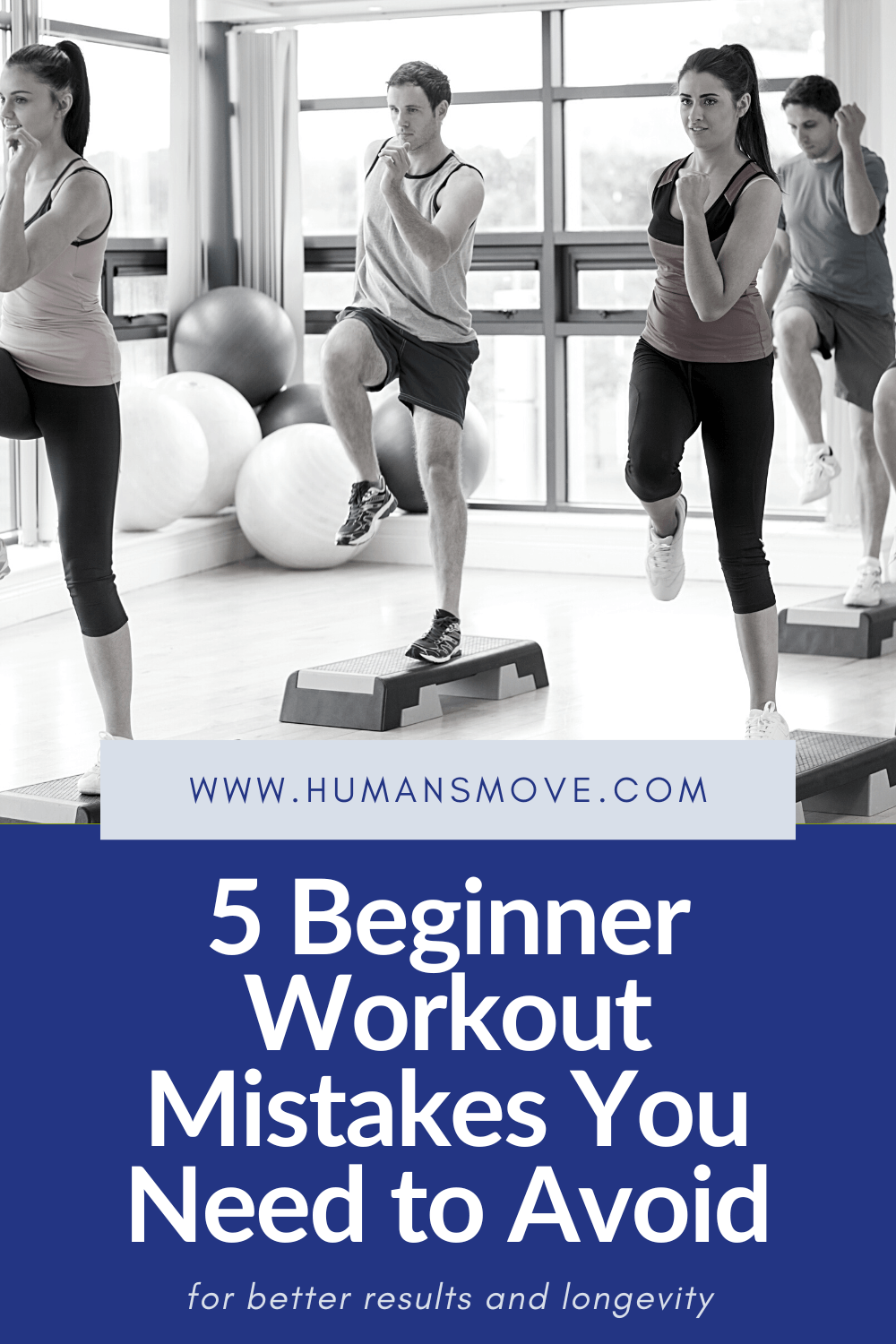5 Beginner workout mistakes you need to avoid for better results (and easier!)

Whether you are a true beginner that has never embarked upon an organized workout routine or you have just been away from it for awhile the best thing you can do to see the best results in the least amount of time is start off on the right by building a foundation that will keep you healthy, pain-free and moving toward your goals. You only have one body to live in and though it is important to move it, it is even more important to take care of the way that it is designed to function so that you can function at a high level for the rest of your life.
Workouts that are too long
There is an age-old belief that many people adopt that in order for your workout to be effective it has to be an hour long. This couldn’t be farther from the truth.
Most gyms set their training sessions and classes for an hour. Online classes are often an hour. Someone just told me that she doesn’t go to the gym if she can’t spend at least an hour working out. This has been prevalent for my entire career!
Let me start by saying that none of my clients workout for an hour. Private training sessions with me are set at 50 minutes which allows time to check client’s alignment, address any issues that we need to outside of the workout itself and of course the workout gets done in that time as well.
When I work with a beginner, the workouts are shorter, but, they workout more often. I also put fewer exercises in the workouts so that they can focus on becoming brilliant at the basic human moves before they take on more complex exercises.
Another reason to keep the workouts to under 40 min as a beginner is that your endurance is lower and you fatigue sooner which opens up the potential to get sloppy. This is the same reason I would keep the reps lower.
Frequency
Beginners need to split their workouts up so that they can focus and become really efficient at the basic human moves. A really simple way to do this is upper body focus one day and lower body focus the next. There are other things to consider, but, I am going to keep it simple for the sake of this article today. Splitting things up means that a beginner should be working out more days than someone who has been at it for awhile.
In general my beginner clients have a workout A and a workout B and will alternate between the two each day for 4-5 days per week. The workouts at this stage are 20-30 min in length. Once a client progresses their workout frequency looks more like 3 full body workouts per week on non-consecutive days. These workouts are usually 30-45 min in length.
There is more to it than that, but, it’s safe to say if you are a true beginner, this is how I would start you out.
Classes as a form of motivation
There are better ways to find motivation to exercise than taking a class for the entertainment or social aspect. Let me be clear, I am not against having fun or socializing while exercising. There are just too many downsides if you are looking to get serious results without getting hurt and you want to build a foundation for a lifetime.
In the class setting you have to keep pace with the class and that very well may not be the right pace for you. Even if you go in planning on going at your own pace, you will more than likely rush and will not be focused on form. That is just the nature of being in a crowd.
Another issue is that you may be looking at people for form that are not using the right form for you. Before you say to yourself “but, the instructor will be checking and correcting my form.” let me stop you. The teacher is there to lead and motivate, not make sure you are moving well. They may stop you if you are doing something obviously unsafe, but, they have many other bodies to look at and a schedule to keep. Even if you are lucky enough to be in a class with a teacher that has the skills to check form and correct you, there isn’t time and their eyes are probably not going to be on you all that much during the class.
I know there are some of you that are not happy with me right now. I have been doing this a long time. If you love classes, go do classes…AFTER you build a solid foundation and move really well. I do recommend personal training if you can, but, I get it. That isn’t accessible for everyone. If you are going to still do classes, find classes that are for beginners lead by professionals that have a strong back ground in biomechanics or hold certifications that are focused on moving better and longevity first.
This has been a really unpopular thing for me to say in the past which is why I wrote this blog a few years ago. Check that out if you insist on taking classes.
THinking soreness is the sign of a good workout
Though you may very well be sore when you are first starting out, it isn’t a sign to go by to determine whether you had a good workout or not. This is not to say that soreness is all bad. It can let you know what you worked! It can also be detrimental if you are regularly getting significantly sore after every workout. Joints should never feel sore. It is important you know the difference between your muscles feeling appropriately sore and a muscle, joint or bone that has pain or tenderness that indicates something more. Over time, your soreness should happen less often.
starting with cardio
I feel like a broken record, but, this is something that still always comes up. People have this idea that starting with cardio is great for beginners. My clients do not do cardio. The only thing that is prescribed to them is their strength workouts that include mobility and some daily corrective exercises and what I call activity. Activity may very well be something that challenges the cardio vascular system. The activity assignment to them is to do active things that they love that requires them to move their body several times a week. I also encourage everyone to walk every day for nervous system regulation.
Think of conventional cardio this way. It is an exercise repeated over and over for thousands of reps. When you are a beginner, your movement patterns have a tendency to be a little dysfunctional. Strength training takes exercises one at a time at a controlled pace in a much more controlled movement pattern and it improves the way you move. Cardio can be rather haphazard. The problem with that is that you are doing thousands of reps with questionnable movement patterns which sets you up for pain and injury. It can strengthen dysfunctions that you have. When you do lower rep strength training with a focus on how you are moving you can build a solid foundation to be able to do cardio if that is what you really want to do down the road.
The bottom line is that you need to make your strength workouts a priority. I encourage to you to start thinking of activity rather than cardio and think of strength training as your key to doing any activity you want for the rest of your life!
Do you have questions or need some guidance?
Are you just starting out or ready to reboot and refresh your routine? Sign up for a free discovery call or leave a question below!
P.S. I do have one opening for private training right now. It is the first time in over a year. If you are interested, sign up for a discovery call today. The opening is on Thursdays online. 🙂💪
FREE DOWNLOAD: 5 insights to
leverage your exercise efforts
Find out how to get into the best shape of your life without spending hours in a
gym.

Hey! If you’re new here…
I’m Rachel. I help people move well so that they can be strong, confident, pain-free and ready for whatever opportunities come their way. I have created a dynamic system to help you maintain a strong sustainable foundation so you never have to “get back in shape” again.
If you have experienced inconsistent results, pain or injury on your quest for fitness you have found yourself in the right place. If you consider yourself a beginner, I am so excited to help you start off on the right foot!
I am a pain-free movement specialist and I have been simplifying fitness for people for 25 years. I hold certifications in movement and nutrition and my education is in physical therapy. I am a bit unconventional in my approach. I consider your long term future as well as your mental well-being when I create programs.
Through my training, you will find clarity and simplicity to support your body in a way that feels good and keeps you moving in the direction you want to go.
Move well, love life
EXPLORE
CONNECT






